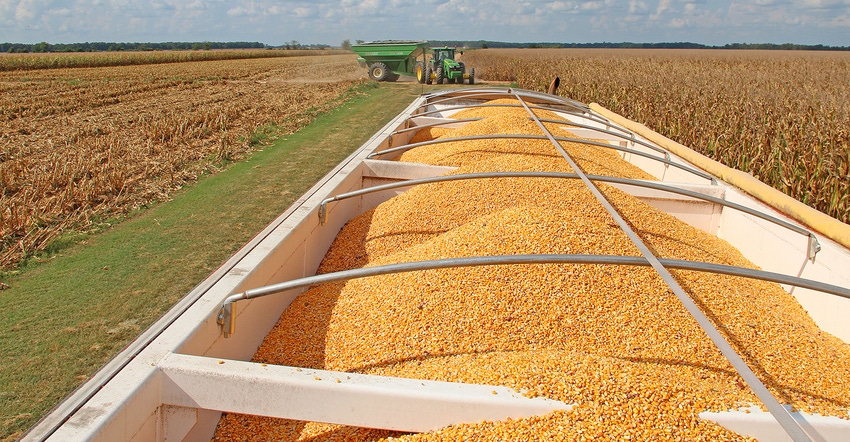
Pat Westhoff says he could have used a lot of complicated charts to demonstrate the impact of the stronger U.S. dollar on U.S. grain exports. Instead, he chose just one – the change in the value of the Mexican peso relative to the dollar since the November elections.
“On election day (Nov. 8) the price of corn on the March futures contract was $3.63 per bushel,” says Dr. Westhoff, the director of the Food and Agriculture Policy Research Institute at the University of Missouri. “As of Thursday (Jan. 5), the price was $3.61 so it hardly changed at all.
“Let’s convert that same price to Mexican pesos, taking the exchange rate on Nov. 8 and the exchange rate today,” he said. “In Mexican peso terms, the equivalent of the March futures contract was 66.5 pesos per bushel on Nov. 8, and it was 77.4 on Thursday (Jan. 5) because the Mexican peso weakened that much against the dollar in that short period of time.”
Thus, while U.S. farmers are receiving slightly lower prices than they were two months ago, Mexican prices have increased significantly because of exchange rate movements, said Westhoff, speaking at the American Farm Bureau Federation’s annual meeting in Phoenix..
And that’s one of the negative factors the grain markets must overcome before growers can have much hope for improved prices, not only for corn, but for soybeans, wheat, cotton and rice, according to Westhoff.
What crop to plant?
The University of Missouri professor, who formerly worked as the chief economist for the Senate Committee on Agriculture, Nutrition and Forestry, was asked during a question-and-answer at the AFBF meeting what crop he would recommend that would be profitable in 2017.
“There’s not many good options right now,” he said. “We have low prices across the board, and that shouldn’t be surprising because if there was a crop that had really good returns, people would be growing it. So things tend to move together, and that’s what we’re seeing right now.”
One set of statistics that is having a major impact on the commodity markets is average yields for the major crops.
“So for 2009 to the present we’ve now had four straight years where the global average yields for those four major crops – corn, soybeans, wheat and rice – has been above the trend of 1982 to the present,” said Westhoff. “That followed three straight years when they were below the trend.
“I have a Ph.D. in economics, and I can make this sound really complicated. But here’s the part that’s not complicated: Every single time since 2009 that the global average yield has exceeded the trend, prices have fallen. Every single time the global average yield has gone below the trend prices have increased. Is this a shock to anybody?”
Normal yields
A return to more normal yields in 2017 could help the commodity price outlook, Westhoff noted.
“One of the big questions marks is have we been above trend for four straight years because of wonderful weather – and, yes, that’s truly part of the story – or is it because of the investments we all made and companies made because of the high prices of the 2008-13 period? It’s probably been a bit of both.”
Yields for global grains and oilseeds have increased by about 1 percent per year since 1980; the same rate as the global growth in population, Westhoff said. Similarly, the area harvested for wheat, rice, corn and soybeans around the world between 2002 and 2014 increased by 17 percent; world per capita consumption is at a 16 percent yearly increase.
“China and biofuels accounted for all the growth in per capita consumption since 1980,” Westhoff said. Ethanol production and an increase in Chinese consumption per capita has had the greatest effect on grains and oilseeds global markets. “Remove those two factors and we have about the same per capita use of grains and oilseeds,” Westhoff said.
Recently, biofuel growth has slowed and there are questions about the future of Chinese growth, as well. The grain and oilseed markets stand to continue current trends because of this, according to Westhoff.
Westhoff’s presentation was part of a workshop on the current outlook for U.S. agriculture conducted by the AFBF’s economics staff.
Dynamic change
While farm income is down across the board, the economists said today’s farm economy is noticeably different than it was in the 1980s.
“We have actually brought on board almost 200 million acres in agricultural production worldwide since 1990,” Bob Young, the AFBF’s chief economist said. “That’s almost the size of U.S. agriculture.”
The demand side of the equation has also increased substantially, said Young, and the tremendous increase in supply and demand has led to price volatility. In the 1980s, non-commercial lending was one-third to one-fourth of all farm lending, while today it is less than five percent. This means producers will have to have a business plan, and they may be more likely to be turned down by commercial lenders.
John Newton, AFBF’s director of market intelligence, said supply of most agricultural commodities has continued to outpace demand, putting pressure on prices. The biofuel boom is over, and livestock is flat, Newton said, so international trade is taking on increasing importance in the global economy. Agricultural exports were $133 billion in 2015, with more than 50 percent of U.S. agricultural trade coming from Mexico, Canada, China and Japan.
For more information about FAPRI, visit http://www.fapri.org/.
About the Author(s)
You May Also Like






